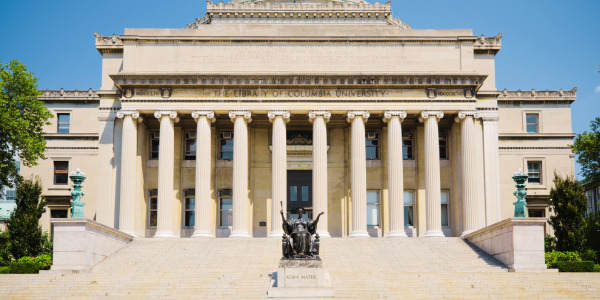Columbia University: Education at Its Finest
Columbia University, located in the vibrant city of New York, stands as one of the world’s most prestigious educational institutions. With a rich history spanning over 250 years, the university has continuously evolved, shaping generations of influential thinkers, leaders, and innovators. This article delves into the captivating journey of Columbia University, highlighting its distinguished academic programs, groundbreaking research, and its commitment to fostering intellectual curiosity and social progress.
Read also: The 5 Best Universities In The United States And Why
Columbia University: A Brief Overview
Columbia University, officially known as Columbia University in the City of New York, established itself in 1754 and ranks among the oldest and most prestigious universities in the United States. Nestled in the Morningside Heights neighborhood of Manhattan, the university spans over 32 acres, with its iconic Low Library serving as a symbol of its academic excellence.
Historical Significance and Founding Principles
Columbia University’s history is steeped in tradition and intellectual pursuit. It was founded under the royal charter of King George II of England and named King’s College. The institution later underwent a transformative change during the American Revolution and became Columbia College, adopting the principles of the newly formed United States. Today, Columbia University remains committed to fostering an environment of academic freedom, critical thinking, and open discourse.
Read also: Why Studying in the US Is a Choice, Know This First
World-Class Academic Programs
Undergraduate Education
At Columbia, undergraduate students embark on a transformative educational journey, guided by a distinguished faculty known for their expertise and passion for teaching. The undergraduate curriculum emphasizes the Core Curriculum, which exposes students to a broad range of subjects, including literature, philosophy, and history. This multidisciplinary approach cultivates well-rounded individuals capable of tackling complex challenges.
Graduate Schools and Professional Programs
Columbia University’s graduate schools and professional programs span a wide array of disciplines, including arts and sciences, business, law, engineering, journalism, medicine, and more. These programs attract top-tier scholars, researchers, and professionals from around the globe, offering an unparalleled educational experience and fostering innovation in their respective fields.
Interdisciplinary Studies
Columbia University is renowned for its commitment to interdisciplinary studies. With its numerous research centers and institutes, the university encourages collaboration across various disciplines to address complex societal issues. Students and faculty have the opportunity to engage in cross-disciplinary research, fostering a culture of innovation and pushing the boundaries of knowledge.
Read also: What is the minimum IELTS test score for studying abroad? There is a University of Your Destination…
Groundbreaking Research and Innovation
Columbia University stands at the forefront of groundbreaking research, driving innovation and contributing to scientific advancements. From pioneering studies in artificial intelligence and climate change to advancements in medical research and public health, Columbia’s research initiatives have had a profound impact on society. The university’s state-of-the-art facilities and collaborative environment provide researchers with the resources and support needed to tackle global challenges.
Global Engagement and Community Impact
Columbia University maintains an unwavering commitment to global engagement and community impact. The university actively encourages its students and faculty to address real-world problems through community service, social entrepreneurship, and international collaborations. Through partnerships with organizations worldwide, Columbia leverages its intellectual capital to effect positive change in local and global communities.
Columbia’s Commitment to Diversity and Inclusion
Diversity and inclusion are fundamental principles at Columbia University. The institution strives to create an environment that celebrates different perspectives, experiences, and backgrounds. Through its recruitment efforts and support services, Columbia fosters a vibrant and inclusive community where all individuals can thrive intellectually, culturally, and socially.
Read also: LPDP Scholarship: Opportunity to Realize Dreams of Studying Abroad
Campus Life and Student Experience
Life at Columbia University is dynamic and engaging. The campus offers a wide range of extracurricular activities, including student organizations, art performances, athletics, and community service opportunities. Students benefit from a vibrant social scene, access to world-class libraries and research facilities, and the chance to explore the diverse neighborhoods of New York City.
Prominent Alumni and Notable Achievements
Columbia University boasts an impressive roster of alumni who have made significant contributions to various fields. From Nobel laureates and Pulitzer Prize winners to business leaders and political figures, Columbia graduates have excelled in their respective endeavors, leaving a lasting impact on society. The university takes pride in its accomplished alumni, who embody the institution’s commitment to excellence and leadership.
Columbia’s Contributions to Society
Throughout its history, Columbia University has made profound contributions to society. From driving scientific breakthroughs and technological advancements to advocating for social justice and human rights, the institution has played a pivotal role in shaping the world we live in today. Columbia’s commitment to fostering intellectual curiosity, critical thinking, and societal impact continues to inspire generations of scholars and changemakers.
Read also: Tips for Successful Interview Scholarships for Studying Abroad
Columbia University stands as a beacon of academic excellence, empowering minds and transforming lives. With its rich history, world-class academic programs, groundbreaking research initiatives, and unwavering commitment to social progress, Columbia continues to inspire and shape the leaders and innovators of tomorrow.
FAQs (Frequently Asked Questions)
1. How old is Columbia University?
Columbia University was founded in 1754, making it over 250 years old.
2. What is the Core Curriculum at Columbia?
The Core Curriculum at Columbia is a set of required courses that expose undergraduate students to a broad range of subjects, providing them with a well-rounded education.
3. Are there scholarships available for students at Columbia University?
Yes, Columbia University offers a range of scholarships and financial aid programs to support students in their educational journey.
4. What are some notable achievements of Columbia University alumni?
Columbia University alumni have achieved notable success in various fields, including academia, business, politics, arts, and sciences. Some notable alumni include Barack Obama, Warren Buffett, and Ruth Bader Ginsburg.
5. How can I get more information about applying to Columbia University?
For more information about applying to Columbia University, visit their official website or contact the admissions office directly.
Columbia University Acceptance Rate
Columbia University in New York City is widely regarded as one of the finest universities in the United States. As a member of the Ivy League, Columbia University’s admissions standards are more stringent than those of other institutions and colleges. It is a highly competitive option for college-bound pupils, as it is currently ranked 18th in National Universities and 5th in Forbes’ Top Colleges List. Understanding the Columbia acceptance rate is crucial when deciding on a college. You will be able to determine if Columbia is a good match for you by carefully considering your admissions prospects and other factors.
As part of your college search strategy, it can be beneficial to consider college acceptance rates. Understanding Columbia’s acceptance rate in greater detail can help you ensure that all aspects of your application stand out. Developing an effective application strategy can increase your likelihood of success. Even though Columbia’s acceptance rate may be lower than that of other institutions, you should still apply.
This article examines Columbia University’s acceptance rate and its implications for prospective students. While the acceptance rate at Columbia University is competitive, we will discuss application and college search strategies. We will also address the significance of college acceptance rates, review admission trends, and examine historical Columbia acceptance rates in detail.
What is the acceptance rate at Columbia University?
The acceptance rate at Columbia for the class of 2026 was 3.73 percent. During the 2022 admissions cycle, 60,377 students applied to Columbia University, but only 2,253 were admitted. Even within the Ivy League, this positions Columbia University among the most selective institutions. The Ivy League admissions process can be difficult, but knowing Columbia’s acceptance rate can help you determine if applying to Columbia is in line with your objectives.
The low acceptance rate at Columbia is partially attributable to the university’s prestige and resources. Columbia is renowned for its robust research program and notable alumni. Numerous students are attracted to Columbia’s academic programs and faculty, making the admissions process to Columbia University extremely competitive.
In addition to its Core Curriculum, which assures a well-rounded liberal arts education, Columbia University offers over 100 majors and concentrations. The Core Curriculum’s emphasis on small class sizes contributes to Columbia University’s low acceptance rate.
Trends in the Columbia Acceptance Rate
In recent years, the Ivy League’s acceptance rates have declined due to an increase in applications. The acceptance rate for Columbia’s class of 2025 was 3.9%, down from 6.1% for the class of 2024. This decline is predominantly attributable to the increase in applications from 2019 to 2020. Although predicting the Columbia University acceptance rate for the class of 2027 is difficult, a further decline would not be unexpected.
In recent years, it was also discovered that the data used to determine Columbia’s ranking contained inaccuracies. It is uncertain how this will affect Columbia’s acceptance rate or admissions process, but it may affect Columbia’s future ranking.
Optional Test Policy
Due to COVID-19, Columbia University has made several requirements optional. This may have caused a surge in college application submissions and a precipitous decline in the acceptance rate. Uncertainty surrounds whether Columbia will adopt a definitive test-optional policy and its long-term impact on Columbia’s acceptance rate. The test-optional policy has been extended through the next two application cycles.
Each year, between sixty and sixty-six percent of admitted students enroll at Columbia University. A high yield rate, which indicates the proportion of admitted students who enroll, indicates that Columbia is an attractive option for admitted students. In spite of Columbia University’s declining acceptance rate in recent years, enrollment numbers have remained stable.
What Does the Acceptance Rate for Columbia Mean for Me?
If you are considering applying to Columbia, it is essential that you comprehend how college acceptance rates work. The low acceptance rate at Columbia dictates that all aspects of your application must be competitive. Even though the Columbia University admissions office has extended its test-optional policy, submitting exceptional SAT and ACT scores will strengthen your application. The median SAT score at Columbia is between 1510 and 1660. Maintaining a high GPA is also crucial, as the low Columbia University acceptance rate suggests that the majority of high school seniors are at the top of their class.
Writing effective supplemental essays can increase your odds of admission to Columbia. The Columbia University application requirements for the 2023-2024 admissions cycle include five 100- to 150-word essays. While writing multiple supplemental essays may seem daunting, they help admissions officers at Columbia University better understand you. Given the low college acceptance rate, exceptional supplemental essays may be required for admission to Columbia.
Pay heed to application requirements. The low acceptance rate at Columbia University should not deter you from applying. If you intend to submit an application to Columbia University, ensure that all aspects of your application meet the institution’s requirements. In addition to your essays, SAT/ACT scores, and grade point average, effective letters of recommendation can help you compete with Columbia’s low acceptance rate.
Due to Columbia University’s admissions rate, many exceptional applicants may be denied admission. The admissions process for Ivy League universities is extremely competitive due to the limited number of available spaces for incoming students. Columbia provides an intimate learning environment and a distinctive campus experience due to its small class sizes. Despite the fact that Columbia’s acceptance rate indicates a highly competitive applicant pool, you won’t know your chances of acceptance until you apply.
What is an Acceptance Rate Worth?
Determining an acceptable college acceptance rate can be difficult and depends on a number of factors. Calculating college acceptance rates involves dividing the number of accepted pupils by the number of applications received. The acceptance rate for Columbia University in 2022 was 3.73 percent, where 2,253 pupils were admitted out of 60,377 applicants. This is an extremely low college acceptance rate, even compared to other highly selective institutions.
The low admittance rate at Columbia suggests a strict admissions policy. Nevertheless, Ivy League acceptance rates are typically modest due to smaller class sizes. As of autumn 2020, approximately 8,100 undergraduates were enrolled at Columbia. With a small number of available slots and a large number of applications, the acceptance rates at Ivy League universities consistently rank among the lowest each year.
The acceptance rate at Columbia University should not be the only factor you consider when applying. Ensure that Columbia University offers your desired field of study and student organizations that match your interests. Focus on whether or not Columbia is a good match for your academic and personal goals, rather than on the school’s acceptance rate. A decent acceptance rate is one that you believe reflects your dedication and determination, regardless of whether it is considered high or low.
Acceptance Rates at Columbia: Early Decision vs. Regular Decision
Annually, the Early Decision acceptance rate at Columbia differs from the Regular Decision acceptance rate. The Columbia Early Decision acceptance rate for the class of 2026 was 10.31%. In response to Early Decision applications from 6,305 students, Columbia University admitted 650 students. The significant difference in acceptance rates is predominantly attributable to the lower number of Early Decision applications received. If Columbia is your primary choice, and you are enthusiastic about attending, you may want to apply Early Decision to take advantage of the higher acceptance rate.
Early Decision applications can affect your overall college search. It is essential to note that early application is not appropriate for everyone. Despite the fact that the Columbia acceptance rate for Regular Decision may appear intimidating, it is imperative that you comprehend the implications of applying Early Decision. Applying early entails submitting your application materials in November, and if Columbia admissions accepts you under the Early Decision plan, you are obligated to enroll if offered admission. Therefore, only submit an early application if you are committed to attending Columbia and have chosen it as your top school.
Acceptance Rate of Columbia and Your College List
When establishing your college list, it is crucial to consider Columbia’s acceptance rate. Ensuring a balance between safety, match, and reach institutions will provide you with a variety of options. Safety institutions are generally where your GPA (and test scores, if applicable) exceed the school’s average. Your match institutions are those where your academic credentials are comparable to those of the typical undergraduate student. Understanding the differences between your ideal and reach schools will assist you in choosing which institutions to prioritize. If the Columbia acceptance rate seems daunting, you may want to add regionally comparable schools to your college list.
Creating a college list should assist you in narrowing down your potential institutions. Given Columbia’s low acceptance rate, all pupils should consider it a reach institution. Include some safety and match institutions on your college list, where a higher acceptance rate can increase your chances of admission. Even though Ivy League admissions are notoriously competitive, a well-rounded college list enables you to be strategic with your Columbia application.
The Columbia University acceptance rate can impact the number of institutions to which you apply. There are numerous highly competitive institutions, but Columbia’s low acceptance rate makes its spots among the most scarce in the nation. You can increase your odds of gaining admission to a school that aligns with your goals by limiting the number of reach schools you apply to. Limiting the number of reach schools can also help you save time and energy for the schools about which you care most. Keep in mind that making informed judgments about your college list is crucial for maximizing your applications.
Additional Columbia University Admissions Information
In addition to the acceptance rate at Columbia, there are a number of other admissions statistics to consider. Despite its low acceptance rate, Columbia is committed to diversifying its student body. The enrollment of students of color, first-generation college students, and Pell-grant-eligible students increased for the class of 2026 at Columbia University.
Despite the fact that Columbia University has adopted a temporary test-optional policy, it is useful to know the average test scores. The average ACT score ranged between 34 and 35, while the average SAT score was 1520. The average weighted GPA was 4.12, highlighting the significance of sustaining a high GPA if you intend to apply to Columbia. Given that the Columbia University acceptance rate reflects a highly competitive applicant pool, it is imperative that students utilize all available resources to distinguish their applications. Possessing a high GPA and test scores can be beneficial.
Graduate Students
The acceptance rate for transfer students at Columbia University differs from the rate for first-year applicants. Similar to the Early Decision acceptance rate, the transfer acceptance rate for the 2022-2023 application cycle is higher at 14.7%. The pool of transfer applicants is typically much smaller than the pool of first-year applicants, resulting in a higher acceptance rate. Consider attending a different institution and submitting a transfer application if the Columbia acceptance rate for first-year students doesn’t align with your plans.
In addition to the acceptance rate at Columbia, financial aid is an important factor. Over fifty percent of admitted students to Columbia’s class of 2026 received need-based financial aid. Columbia is committed to meeting all first-year students’ demonstrated financial need, making it an excellent choice for families.
Acceptance Rate at Columbia Final Thoughts
The acceptance rate at Columbia University is among the lowest in the nation. If you intend to apply to Columbia, preparation is essential because it is unlikely that the acceptance rate will increase substantially in the near future. Determine whether Columbia matches your academic interests and personal objectives. Investigate the academic programs, extracurricular opportunities, research opportunities, and campus life of the university. Devote time and effort to composing strong supplemental essays, as they provide a comprehensive look at your identity and your interest in Columbia. Be strategic with your recommendation letters and participate in a variety of activities.
Consider applying Early Decision to Columbia if you are certain it is your primary choice. Due to Columbia’s low acceptance rate, it may be advantageous to submit early and be among a smaller applicant pool.
Do not let the low admittance rate at Columbia University intimidate you. Explore our webinar with alumni of Columbia University for more information on the application process and Columbia University. Here you can also examine our detailed guide on how to enter Columbia. Research will ensure that you make the most of the college admissions process, even though applying to college can be intimidating.









